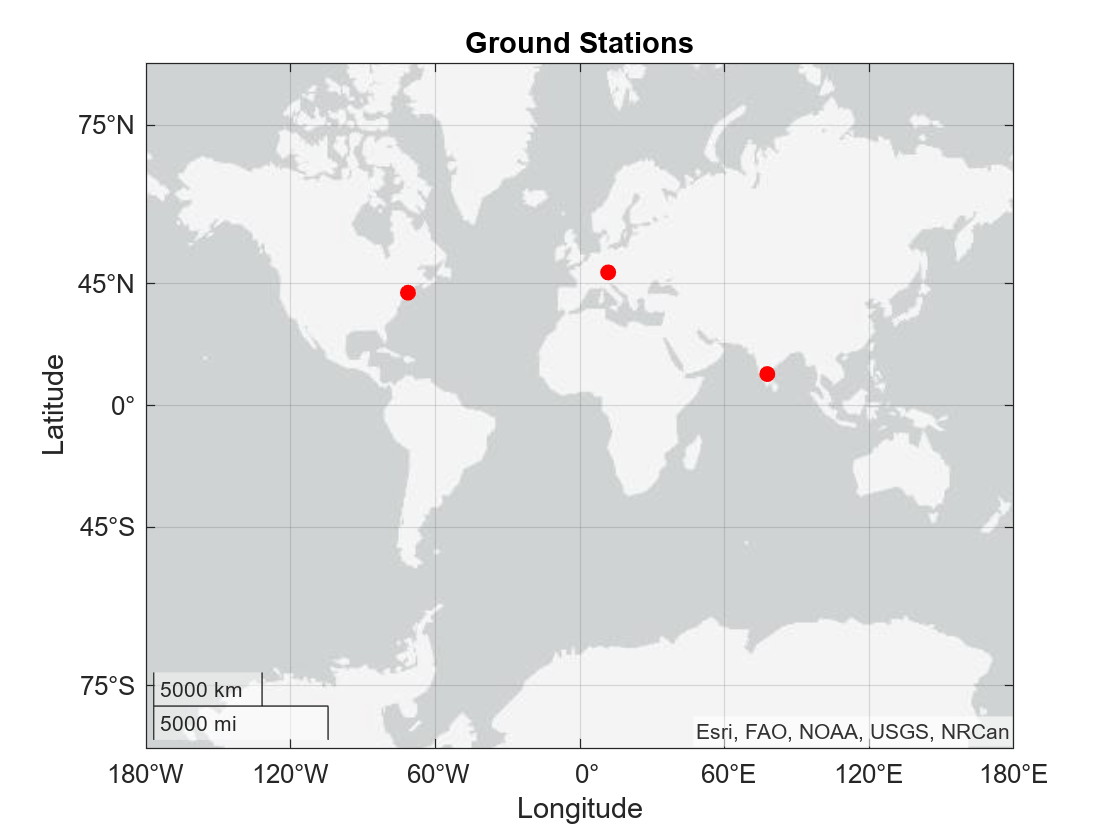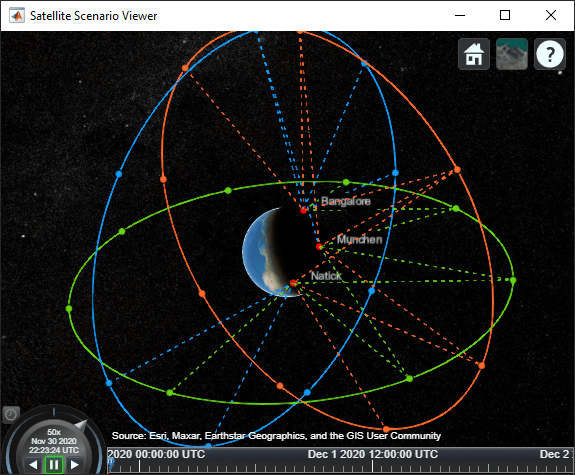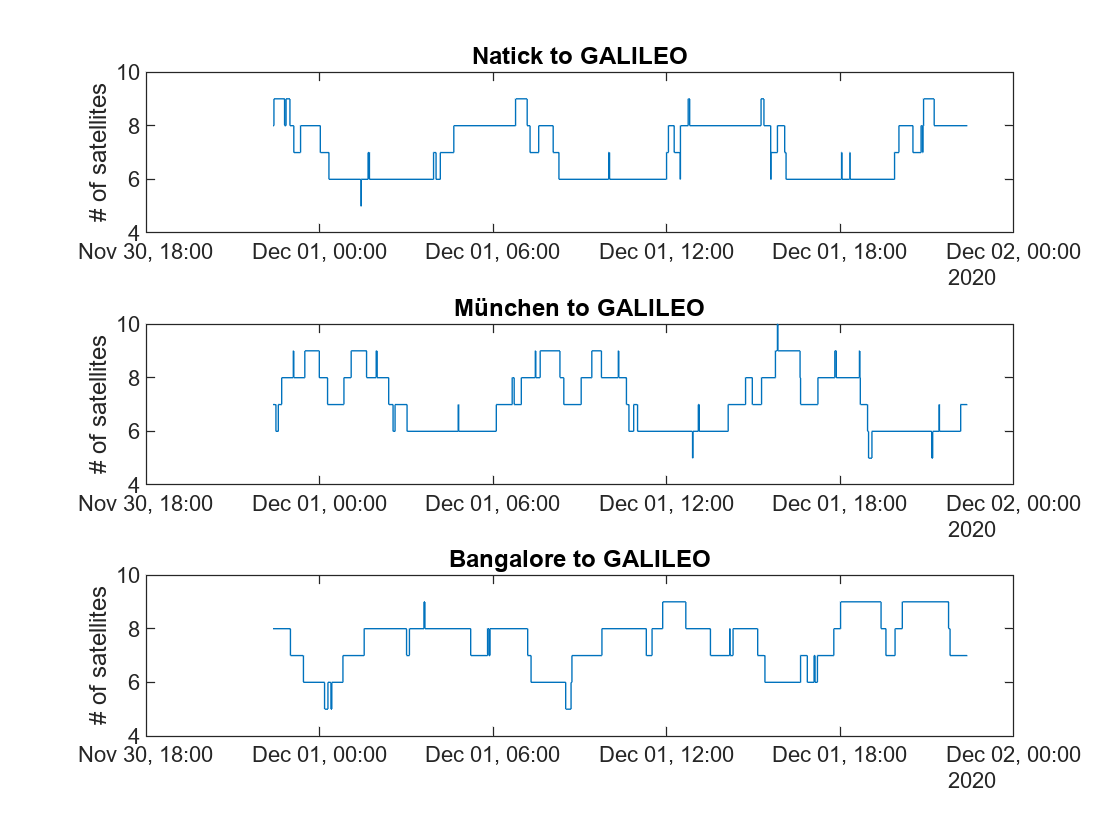Modeling Satellite Constellations Using Ephemeris Data
This example demonstrates how to add time-stamped ephemeris data for a constellation of 24 satellites (similar to ESA Galileo GNSS constellation) to a satellite scenario for access analysis. The example uses data generated by the Aerospace Blockset Orbit Propagator block. For more information, see the Aerospace Blockset example Constellation Modeling with the Orbit Propagator Block.
The satelliteScenario object supports loading previously generated, time-stamped satellite ephemeris data into a scenario from a timeseries or timetable object. An ephemeris is a table containing position (and optionally velocity) state information of a satellite during a given period of time. Ephemeris data used to add satellites to the scenario object is interpolated via the makima interpolation method to align with the scenario time steps. This allows you to incorporate data generated by a Simulink model into either a new or existing satelliteScenario.
Define Mission Parameters and Constellation Initial Conditions
Specify a start date and duration for the mission. This example uses MATLAB structures to organize mission data. These structures make accessing data later in the example more intuitive. They also help declutter the global base workspace.
mission.StartDate = datetime(2020, 11, 30, 22, 23, 24); mission.Duration = hours(24);
The constellation in this example is a Walker-Delta constellation modeled similar to Galileo, the European GNSS (global navigation satellite system) constellation. The constellation consists of 24 satellites in medium Earth orbit (MEO). The satellites' Keplerian orbital elements at the mission start date epoch are:
mission.ConstellationDefinition = table( ... 29599.8e3 * ones(24,1), ... % Semi-major axis (m) 0.0005 * ones(24,1), ... % Eccentricity 56 * ones(24,1), ... % Inclination (deg) 350 * ones(24,1), ... % Right ascension of the ascending node (deg) sort(repmat([0 120 240], 1,8))', ... % Argument of periapsis (deg) [0:45:315, 15:45:330, 30:45:345]', ... % True anomaly (deg) 'VariableNames', ["a (m)", "e", "i (deg)", ... "Ω (deg)", "ω (deg)", "ν (deg)"]); mission.ConstellationDefinition
ans=24×6 table
a (m) e i (deg) Ω (deg) ω (deg) ν (deg)
________ ______ _______ _______ _______ _______
2.96e+07 0.0005 56 350 0 0
2.96e+07 0.0005 56 350 0 45
2.96e+07 0.0005 56 350 0 90
2.96e+07 0.0005 56 350 0 135
2.96e+07 0.0005 56 350 0 180
2.96e+07 0.0005 56 350 0 225
2.96e+07 0.0005 56 350 0 270
2.96e+07 0.0005 56 350 0 315
2.96e+07 0.0005 56 350 120 15
2.96e+07 0.0005 56 350 120 60
2.96e+07 0.0005 56 350 120 105
2.96e+07 0.0005 56 350 120 150
2.96e+07 0.0005 56 350 120 195
2.96e+07 0.0005 56 350 120 240
2.96e+07 0.0005 56 350 120 285
2.96e+07 0.0005 56 350 120 330
⋮
Load Ephemeris Timeseries Data
The timeseries objects contain position and velocity data for all 24 satellites in the constellation. The data is referenced in the International Terrestrial Reference frame (ITRF), which is an Earth-centered Earth-fixed (ECEF) coordinate system. The data was generated using the Aerospace Blockset Orbit Propagator block. For more information, see the Aerospace Blockset example Constellation Modeling with the Orbit Propagator Block.
mission.Ephemeris = load("SatelliteScenarioEphemerisData.mat", "TimeseriesPosITRF", "TimeseriesVelITRF"); mission.Ephemeris.TimeseriesPosITRF
timeseries
Common Properties:
Name: ''
Time: [57x1 double]
TimeInfo: [1x1 tsdata.timemetadata]
Data: [24x3x57 double]
DataInfo: [1x1 tsdata.datametadata]
More properties, Methods
mission.Ephemeris.TimeseriesVelITRF
timeseries
Common Properties:
Name: ''
Time: [57x1 double]
TimeInfo: [1x1 tsdata.timemetadata]
Data: [24x3x57 double]
DataInfo: [1x1 tsdata.datametadata]
More properties, Methods
Load the Satellite Ephemerides into a satelliteScenario Object
Create a satellite scenario object for the analysis.
scenario = satelliteScenario(mission.StartDate, mission.StartDate + hours(24), 60);
Use the satellite method to add all 24 satellites to the satellite scenario from the ECEF position and velocity timeseries objects. This example uses position and velocity information; however satellites can also be added from position data only and velocity states are then estimated. Available coordinate frames for Name-Value pair CoordinateFrame are "ECEF", "Inertial", and "Geographic". If the timeseries object contains a value for ts.TimeInfo.StartDate, the method uses that value as the epoch for the timeseries object. If no StartDate is defined, the method uses the scenario start date by default.
sat = satellite(scenario, mission.Ephemeris.TimeseriesPosITRF, mission.Ephemeris.TimeseriesVelITRF, ... CoordinateFrame="ecef", Name="GALILEO " + (1:24))
sat =
1x24 Satellite array with properties:
Name
ID
PhysicalProperties
ConicalSensors
Gimbals
Transmitters
Receivers
Accesses
Eclipse
GroundTrack
Orbit
CoordinateAxes
OrbitPropagator
MarkerColor
MarkerSize
ShowLabel
LabelFontColor
LabelFontSize
Visual3DModel
Visual3DModelScale
disp(scenario)
satelliteScenario with properties:
StartTime: 30-Nov-2020 22:23:24
StopTime: 01-Dec-2020 22:23:24
SampleTime: 60
AutoSimulate: 1
CentralBodyOptions: [1×1 Aero.satellitescenario.CentralBodyOptions]
Satellites: [1×24 matlabshared.satellitescenario.Satellite]
GroundStations: [1×0 matlabshared.satellitescenario.GroundStation]
Platforms: [1×0 matlabshared.satellitescenario.Platform]
Viewers: [0×0 matlabshared.satellitescenario.Viewer]
AutoShow: 1
Alternatively, satellites can also be added as ephemerides to the satellite scenario as a MATLAB timetable, table, or tscollection. For example, a timetable containing the first 3 satellites of the position timeseries object in the previous section, formatted for use with satelliteScenario objects is shown below.
Satellites are represented by variables (column headers).
Each row contains a position vector associated with the row's
Timeproperty.
timetable(... datetime(getabstime(mission.Ephemeris.TimeseriesPosITRF), Locale="en_US"), ... squeeze(mission.Ephemeris.TimeseriesPosITRF.Data(1,:,:))', ... squeeze(mission.Ephemeris.TimeseriesPosITRF.Data(2,:,:))', ... squeeze(mission.Ephemeris.TimeseriesPosITRF.Data(3,:,:))',... VariableNames=["Satellite_1", "Satellite_2", "Satellite_3"])
ans=57×3 timetable
Time Satellite_1 Satellite_2 Satellite_3
____________________ ________________________________________ ________________________________________ ________________________________________
30-Nov-2020 22:23:24 1.8249e+07 -2.2904e+07 -4.2009e+06 2.3678e+07 -1.075e+07 1.4119e+07 1.5239e+07 7.7076e+06 2.4177e+07
30-Nov-2020 22:23:38 1.8252e+07 -2.2909e+07 -4.1563e+06 2.3662e+07 -1.0735e+07 1.4156e+07 1.5214e+07 7.7334e+06 2.4184e+07
30-Nov-2020 22:24:53 1.8268e+07 -2.2937e+07 -3.933e+06 2.3584e+07 -1.0663e+07 1.434e+07 1.5088e+07 7.8627e+06 2.4222e+07
30-Nov-2020 22:31:05 1.8326e+07 -2.3055e+07 -2.8121e+06 2.3185e+07 -1.028e+07 1.5243e+07 1.4466e+07 8.5229e+06 2.4378e+07
30-Nov-2020 22:48:39 1.8326e+07 -2.3223e+07 3.9182e+05 2.2005e+07 -8.9966e+06 1.7621e+07 1.2798e+07 1.0506e+07 2.4539e+07
30-Nov-2020 23:08:30 1.8076e+07 -2.3078e+07 3.9992e+06 2.0643e+07 -7.2057e+06 1.9943e+07 1.1124e+07 1.2894e+07 2.4217e+07
30-Nov-2020 23:28:27 1.7624e+07 -2.2538e+07 7.5358e+06 1.9321e+07 -5.0678e+06 2.1838e+07 9.7076e+06 1.5379e+07 2.3362e+07
30-Nov-2020 23:50:59 1.6968e+07 -2.1428e+07 1.1328e+07 1.7977e+07 -2.3021e+06 2.34e+07 8.4636e+06 1.8183e+07 2.1782e+07
01-Dec-2020 00:14:27 1.6244e+07 -1.9712e+07 1.4937e+07 1.6838e+07 8.7771e+05 2.4329e+07 7.5789e+06 2.0966e+07 1.9489e+07
01-Dec-2020 00:38:42 1.5585e+07 -1.7375e+07 1.8189e+07 1.6017e+07 4.355e+06 2.4512e+07 7.0779e+06 2.3551e+07 1.6498e+07
01-Dec-2020 01:04:35 1.5124e+07 -1.4345e+07 2.1006e+07 1.5585e+07 8.1065e+06 2.383e+07 6.9314e+06 2.5831e+07 1.2718e+07
01-Dec-2020 01:31:17 1.5035e+07 -1.079e+07 2.3096e+07 1.562e+07 1.1816e+07 2.2205e+07 7.0715e+06 2.7527e+07 8.3282e+06
01-Dec-2020 01:58:58 1.5443e+07 -6.8501e+06 2.4303e+07 1.6102e+07 1.5274e+07 1.9601e+07 7.348e+06 2.8484e+07 3.4363e+06
01-Dec-2020 02:27:08 1.6406e+07 -2.8152e+06 2.4478e+07 1.6925e+07 1.8197e+07 1.6103e+07 7.5521e+06 2.8587e+07 -1.6897e+06
01-Dec-2020 02:55:18 1.7869e+07 1.001e+06 2.3582e+07 1.7894e+07 2.0376e+07 1.1901e+07 7.4614e+06 2.7856e+07 -6.7427e+06
01-Dec-2020 03:23:29 1.9711e+07 4.381e+06 2.1653e+07 1.8787e+07 2.1739e+07 7.1754e+06 6.8858e+06 2.6405e+07 -1.1504e+07
⋮
Set Graphical Properties on the Satellites
Set satellite in the same orbital plane to have the same orbit color.
set(sat(1:8), MarkerColor="#FF6929"); set(sat(9:16), MarkerColor="#139FFF"); set(sat(17:24), MarkerColor="#64D413"); orbit = [sat(:).Orbit]; set(orbit(1:8), LineColor="#FF6929"); set(orbit(9:16), LineColor="#139FFF"); set(orbit(17:24), LineColor="#64D413");
Add Ground Stations to Scenario
To provide accurate positioning data, a location on Earth must have access to at least 4 satellites in the constellation at any given time. In this example, use three locations to compare total constellation access over the 1 day analysis window to different regions of Earth:
Natick, Massachusetts, USA (42.30048°, -71.34908°)
München, Germany (48.23206°, 11.68445°)
Bangalore, India (12.94448°, 77.69256°)
gsUS = groundStation(scenario, 42.30048, -71.34908, ... MinElevationAngle=10, Name="Natick"); gsUS.MarkerColor = "red"; gsDE = groundStation(scenario, 48.23206, 11.68445, ... MinElevationAngle=10, Name="Munchen"); gsDE.MarkerColor = "red"; gsIN = groundStation(scenario, 12.94448, 77.69256, ... MinElevationAngle=10, Name="Bangalore"); gsIN.MarkerColor = "red"; figure geoscatter([gsUS.Latitude gsDE.Latitude gsIN.Latitude], ... [gsUS.Longitude gsDE.Longitude gsIN.Longitude], "red", "filled") geolimits([-75 75], [-180 180]) title("Ground Stations")

Compute Ground Station to Satellite Access (Line-of-Sight Visibility)
Calculate line-of-sight access between the ground stations and each individual satellite using the access method.
accessUS = access(gsUS, sat); accessDE = access(gsDE, sat); accessIN = access(gsIN, sat);
Set access colors to match orbital plane colors assigned earlier in the example.
set(accessUS, LineWidth="1"); set(accessUS(1:8), LineColor="#FF6929"); set(accessUS(9:16), LineColor="#139FFF"); set(accessUS(17:24), LineColor="#64D413"); set(accessDE, LineWidth="1"); set(accessDE(1:8), LineColor="#FF6929"); set(accessDE(9:16), LineColor="#139FFF"); set(accessDE(17:24), LineColor="#64D413"); set(accessIN, LineWidth="1"); set(accessIN(1:8), LineColor="#FF6929"); set(accessIN(9:16), LineColor="#139FFF"); set(accessIN(17:24), LineColor="#64D413");
View the full access table between each ground station and all satellites in the constellation as tables. Sort the access intervals by interval start time. Satellites added from ephemeris data do not display values for StartOrbit and EndOrbit.
intervalsUS = accessIntervals(accessUS); intervalsUS = sortrows(intervalsUS, "StartTime", "ascend")
intervalsUS=40×8 table
Source Target IntervalNumber StartTime EndTime Duration StartOrbit EndOrbit
________ ____________ ______________ ____________________ ____________________ ________ __________ ________
"Natick" "GALILEO 1" 1 30-Nov-2020 22:23:24 01-Dec-2020 04:04:24 20460 NaN NaN
"Natick" "GALILEO 2" 1 30-Nov-2020 22:23:24 01-Dec-2020 01:24:24 10860 NaN NaN
"Natick" "GALILEO 3" 1 30-Nov-2020 22:23:24 30-Nov-2020 22:57:24 2040 NaN NaN
"Natick" "GALILEO 12" 1 30-Nov-2020 22:23:24 01-Dec-2020 00:00:24 5820 NaN NaN
"Natick" "GALILEO 13" 1 30-Nov-2020 22:23:24 30-Nov-2020 23:05:24 2520 NaN NaN
"Natick" "GALILEO 18" 1 30-Nov-2020 22:23:24 01-Dec-2020 04:00:24 20220 NaN NaN
"Natick" "GALILEO 19" 1 30-Nov-2020 22:23:24 01-Dec-2020 01:42:24 11940 NaN NaN
"Natick" "GALILEO 20" 1 30-Nov-2020 22:23:24 30-Nov-2020 22:46:24 1380 NaN NaN
"Natick" "GALILEO 11" 1 30-Nov-2020 22:25:24 01-Dec-2020 00:18:24 6780 NaN NaN
"Natick" "GALILEO 17" 1 30-Nov-2020 22:50:24 01-Dec-2020 05:50:24 25200 NaN NaN
"Natick" "GALILEO 8" 1 30-Nov-2020 23:20:24 01-Dec-2020 07:09:24 28140 NaN NaN
"Natick" "GALILEO 7" 1 01-Dec-2020 01:26:24 01-Dec-2020 10:00:24 30840 NaN NaN
"Natick" "GALILEO 24" 1 01-Dec-2020 01:40:24 01-Dec-2020 07:12:24 19920 NaN NaN
"Natick" "GALILEO 14" 1 01-Dec-2020 03:56:24 01-Dec-2020 07:15:24 11940 NaN NaN
"Natick" "GALILEO 6" 1 01-Dec-2020 04:05:24 01-Dec-2020 12:14:24 29340 NaN NaN
"Natick" "GALILEO 23" 1 01-Dec-2020 04:10:24 01-Dec-2020 08:03:24 13980 NaN NaN
⋮
intervalsDE = accessIntervals(accessDE); intervalsDE = sortrows(intervalsDE, "StartTime", "ascend")
intervalsDE=40×8 table
Source Target IntervalNumber StartTime EndTime Duration StartOrbit EndOrbit
_________ ____________ ______________ ____________________ ____________________ ________ __________ ________
"Munchen" "GALILEO 2" 1 30-Nov-2020 22:23:24 01-Dec-2020 04:34:24 22260 NaN NaN
"Munchen" "GALILEO 3" 1 30-Nov-2020 22:23:24 01-Dec-2020 01:58:24 12900 NaN NaN
"Munchen" "GALILEO 4" 1 30-Nov-2020 22:23:24 30-Nov-2020 23:05:24 2520 NaN NaN
"Munchen" "GALILEO 10" 1 30-Nov-2020 22:23:24 30-Nov-2020 23:58:24 5700 NaN NaN
"Munchen" "GALILEO 19" 1 30-Nov-2020 22:23:24 01-Dec-2020 01:36:24 11580 NaN NaN
"Munchen" "GALILEO 20" 1 30-Nov-2020 22:23:24 01-Dec-2020 00:15:24 6720 NaN NaN
"Munchen" "GALILEO 21" 1 30-Nov-2020 22:23:24 30-Nov-2020 22:28:24 300 NaN NaN
"Munchen" "GALILEO 9" 1 30-Nov-2020 22:34:24 01-Dec-2020 02:22:24 13680 NaN NaN
"Munchen" "GALILEO 18" 1 30-Nov-2020 22:41:24 01-Dec-2020 02:31:24 13800 NaN NaN
"Munchen" "GALILEO 1" 1 30-Nov-2020 23:05:24 01-Dec-2020 06:42:24 27420 NaN NaN
"Munchen" "GALILEO 16" 1 30-Nov-2020 23:29:24 01-Dec-2020 04:47:24 19080 NaN NaN
"Munchen" "GALILEO 15" 1 01-Dec-2020 00:50:24 01-Dec-2020 07:27:24 23820 NaN NaN
"Munchen" "GALILEO 17" 1 01-Dec-2020 01:05:24 01-Dec-2020 03:00:24 6900 NaN NaN
"Munchen" "GALILEO 8" 1 01-Dec-2020 01:57:24 01-Dec-2020 08:25:24 23280 NaN NaN
"Munchen" "GALILEO 14" 1 01-Dec-2020 02:36:24 01-Dec-2020 10:19:24 27780 NaN NaN
"Munchen" "GALILEO 7" 1 01-Dec-2020 04:35:24 01-Dec-2020 09:43:24 18480 NaN NaN
⋮
intervalsIN = accessIntervals(accessIN); intervalsIN = sortrows(intervalsIN, "StartTime", "ascend")
intervalsIN=31×8 table
Source Target IntervalNumber StartTime EndTime Duration StartOrbit EndOrbit
___________ ____________ ______________ ____________________ ____________________ ________ __________ ________
"Bangalore" "GALILEO 3" 1 30-Nov-2020 22:23:24 01-Dec-2020 05:12:24 24540 NaN NaN
"Bangalore" "GALILEO 4" 1 30-Nov-2020 22:23:24 01-Dec-2020 02:59:24 16560 NaN NaN
"Bangalore" "GALILEO 5" 1 30-Nov-2020 22:23:24 01-Dec-2020 00:22:24 7140 NaN NaN
"Bangalore" "GALILEO 9" 1 30-Nov-2020 22:23:24 01-Dec-2020 03:37:24 18840 NaN NaN
"Bangalore" "GALILEO 10" 1 30-Nov-2020 22:23:24 01-Dec-2020 00:09:24 6360 NaN NaN
"Bangalore" "GALILEO 16" 1 30-Nov-2020 22:23:24 01-Dec-2020 08:44:24 37260 NaN NaN
"Bangalore" "GALILEO 21" 1 30-Nov-2020 22:23:24 30-Nov-2020 23:25:24 3720 NaN NaN
"Bangalore" "GALILEO 22" 1 30-Nov-2020 22:23:24 30-Nov-2020 22:58:24 2100 NaN NaN
"Bangalore" "GALILEO 15" 1 01-Dec-2020 00:17:24 01-Dec-2020 11:16:24 39540 NaN NaN
"Bangalore" "GALILEO 2" 1 01-Dec-2020 00:25:24 01-Dec-2020 07:10:24 24300 NaN NaN
"Bangalore" "GALILEO 22" 2 01-Dec-2020 00:48:24 01-Dec-2020 05:50:24 18120 NaN NaN
"Bangalore" "GALILEO 21" 2 01-Dec-2020 01:32:24 01-Dec-2020 08:29:24 25020 NaN NaN
"Bangalore" "GALILEO 1" 1 01-Dec-2020 03:06:24 01-Dec-2020 07:17:24 15060 NaN NaN
"Bangalore" "GALILEO 20" 1 01-Dec-2020 03:36:24 01-Dec-2020 12:38:24 32520 NaN NaN
"Bangalore" "GALILEO 14" 1 01-Dec-2020 05:48:24 01-Dec-2020 13:29:24 27660 NaN NaN
"Bangalore" "GALILEO 19" 1 01-Dec-2020 05:53:24 01-Dec-2020 17:06:24 40380 NaN NaN
⋮
View the Satellite Scenario
Open a 3-D viewer window of the scenario. The viewer window contains all 24 satellites and the three ground stations defined earlier in this example. A line is drawn between each ground station and satellite during their corresponding access intervals. Hide the details of the satellites and ground stations by setting the ShowDetails name-value pair to false. Show satellite orbits and labels for the ground station locations.
viewer3D = satelliteScenarioViewer(scenario, ShowDetails=false); show(sat.Orbit); gsUS.ShowLabel = true; gsUS.LabelFontSize = 11; gsDE.ShowLabel = true; gsDE.LabelFontSize = 11; gsIN.ShowLabel = true; gsIN.LabelFontSize = 11;

Compare Access Between Ground Stations
Calculate access status between each satellite and ground station using the accessStatus method. Each row of the output array corresponds with a satellite in the constellation. Each column corresponds with time steps in the scenario. A value of True indicates that the satellite can access the aircraft at that specific time sample. The second output of accessStatus contains the time steps of the scenario. Plot cumulative access for each ground station over the one day analysis window.
[statusUS, timeSteps] = accessStatus(accessUS); statusDE = accessStatus(accessDE); statusIN = accessStatus(accessIN); % Sum cumulative access at each timestep statusUS = sum(statusUS, 1); statusDE = sum(statusDE, 1); statusIN = sum(statusIN, 1); subplot(3,1,1); stairs(timeSteps, statusUS); title("Natick to GALILEO") ylabel("# of satellites") subplot(3,1,2); stairs(timeSteps, statusDE); title("München to GALILEO") ylabel("# of satellites") subplot(3,1,3); stairs(timeSteps, statusIN); title("Bangalore to GALILEO") ylabel("# of satellites")

Collect access interval metrics for each ground station in a table for comparison.
statusTable = [table(height(intervalsUS), height(intervalsDE), height(intervalsIN)); ... table(sum(intervalsUS.Duration)/3600, sum(intervalsDE.Duration)/3600, sum(intervalsIN.Duration)/3600); ... table(mean(intervalsUS.Duration/60), mean(intervalsDE.Duration/60), mean(intervalsIN.Duration/60)); ... table(mean(statusUS, 2), mean(statusDE, 2), mean(statusIN, 2)); ... table(min(statusUS), min(statusDE), min(statusIN)); ... table(max(statusUS), max(statusDE), max(statusIN))]; statusTable.Properties.VariableNames = ["Natick", "München", "Bangalore"]; statusTable.Properties.RowNames = ["Total # of intervals", "Total interval time (hrs)",... "Mean interval length (min)", "Mean # of satellites in view", ... "Min # of satellites in view", "Max # of satellites in view"]; statusTable
statusTable=6×3 table
Natick München Bangalore
______ _______ _________
Total # of intervals 40 40 31
Total interval time (hrs) 167.88 169.95 180.42
Mean interval length (min) 251.82 254.93 349.19
Mean # of satellites in view 7.018 7.1041 7.5337
Min # of satellites in view 5 5 5
Max # of satellites in view 9 10 9
Walker-Delta constellations like Galileo are evenly distributed across longitudes. Natick and München are located at similar latitudes, and therefore have very similar access characteristics with respect to the constellation. Bangalore is at a latitude closer to the equator. Despite having a lower number of individual access intervals, it has the highest average number of satellites in view, the highest overall interval time, and the longest average interval duration (by about 95 minutes). All locations always have at least 4 satellites in view, as is required for GNSS trilateration.
References
[1] Wertz, James R, David F. Everett, and Jeffery J. Puschell. Space Mission Engineering: The New Smad. Hawthorne, CA: Microcosm Press, 2011. Print.
[2] The European Space Agency: Galileo Facts and Figures. https://www.esa.int/Applications/Navigation/Galileo/Facts_and_figures
See Also
Objects
satelliteScenario|satellite|access|groundStation|satelliteScenarioViewer|conicalSensor|transmitter|receiver
Functions
Topics
- Multi-Hop Satellite Communications Link Between Two Ground Stations
- Satellite Constellation Access to Ground Station
- Comparison of Orbit Propagators
- Estimate GNSS Receiver Position with Simulated Satellite Constellations
- Model, Visualize, and Analyze Satellite Scenario
- Satellite Scenario Key Concepts
- Satellite Scenario Basics